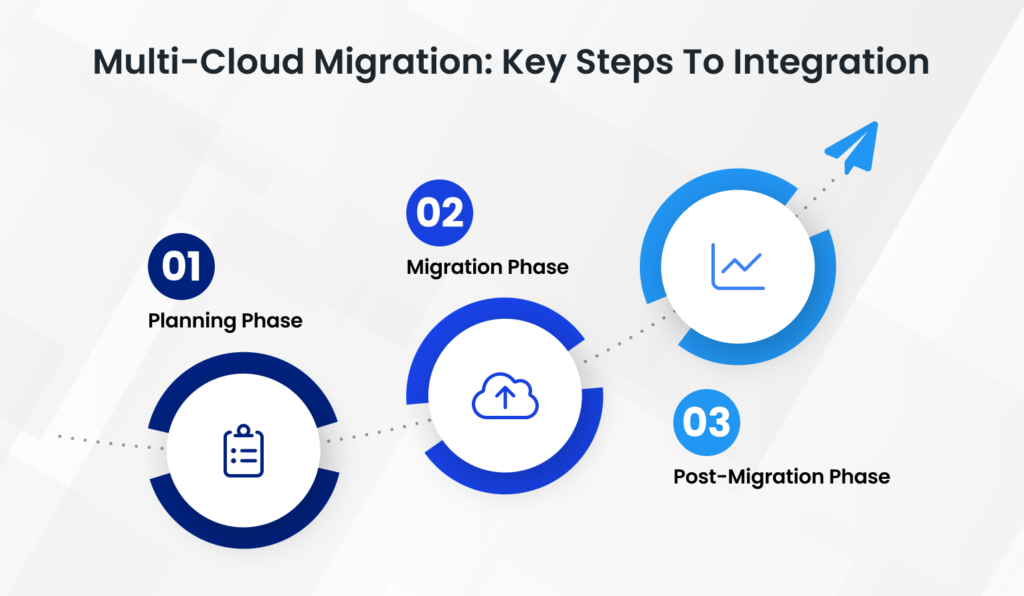In multi-cloud strategies of cloud computing, more businesses are focusing on the strengths and virtues of individual cloud service providers rather than using one in a traditional manner.
The evolving landscape of cloud computing, with a staggering 92% of firms adopting multi-cloud, brings with it a new set of complexities. The urgency to navigate these complexities and master the art of multi-cloud migration has never been more important.
The incidence of cloud spending surpassing millions a year requires organizations to optimize their multi-cloud environments cost-wise in terms of security and application compatibility.
In this guide, we’ll delve into the step-by-step process of multi-cloud migration to help businesses harness the full potential of their cloud ecosystems while mitigating risks and maximizing benefits.
What is a Multi Cloud?
Multicloud is a strategic cloud computing concept that involves using two or more cloud service providers’ services to meet the diverse business needs of companies, organizations, or institutions.
Multicloud environments diversify their options by utilizing the attributes of different cloud providers, bringing together more services and features. The multicloud climate allows other providers to supply custom services that meet specific business requirements.
For example, Microsoft and Google Cloud excel in real-time collaboration and messaging tools and sophisticated data analytics services.
Multicloud strategy enables organizations to tap into the exceptional offerings of different providers, leaving the opportunity to operate outside of the limited scope of one vendor.
Mention that multicloud and hybrid cloud also includes on-premises infrastructure integration with different cloud service providers.
On the other hand, multicloud particularly means the use of different public clouds instead of a whole private cloud atmosphere and public clouds.
Multicloud enables companies to have flexibility, reliability, and agility of cloud operations as they can deploy the supreme services from different cloud vendors.
This strategy minimizes the dangers connected to vendor lock-in and single points of failure and maximizes the given technology’s features in a wide range of business functions.
What is a Multi Cloud Migration?
Multi-cloud migration transfers applications, workloads, data, and other IT resources from an on-premises environment or one cloud environment to a few or more than one cloud environment(s).
This process involves transferring assets to various types of cloud systems like AWS, Azure, GCP, and other public or private cloud services.
In this multi-cloud migration scenario, entities may decide to distribute their resources across multiple cloud providers to take advantage of the additional features and advantages provided by these platforms.
It allows businesses to avoid the designated vendor lock-in, gain extra redundancy and resilience, optimize application performance, and mitigate performance risks in cases where only a singular cloud provider is relied on.
Moving to a multi-cloud environment involves strategizing, evaluating, and implementing to ensure that the transition occurs with the most minor interruptions to business.
The procedure embraces assessing the apps and workloads’ suitability for each of the cloud platforms and finding an appropriate migration strategy (lift-and-shift, re-platforming, re-architecting).
It is also about data transfer and synchronization, handling security and compliance, and managing the costs to be used in different cloud systems cost-effectively.

Diversify Your Cloud Portfolio: Begin Your Multi-Cloud Migration Journey Now!
Harness the strengths of multiple cloud providers to optimize performance and resilience.
Steps of a Multi Cloud Migration Integration
Migrating to the multi-cloud set is becoming less rare as companies try to take advantage of the differences between cloud suppliers to comply with various business requirements.
Successful multi-cloud migration needs deliberate planning, implementation, and post-migration governance.
Below are the key steps involved in seamlessly integrating multiple cloud platforms. These steps can help organizations overcome the difficulties of multicloud migration and ultimately reap the full benefits of the cloud platform.

Planning phase
- Assess and Determine Scope of Needs: Define the requirements for the multi-cloud platform, including functions and services to be migrated, and consider factors like vendor options and regulatory compliance.
- Assess and Determine Budget and Costs: Evaluate the available funding against the estimated migration costs, considering various pricing models vendors offer.
- Identify Stakeholders and Responsibilities: Involve key personnel from different departments and assign roles and responsibilities for tasks related to the migration.
- Ensure Valid Users, Data, and Services: Validate active user accounts, relevant data, and essential services for migration to optimize resources.
- Take Inventory of Migration Components: Compile a comprehensive list of components to be migrated, prioritizing them based on importance.
- Prioritize Migration Components: Decide the order in which components will be migrated based on their criticality and relevance.
- Determine Necessary Permissions and Access: Define access requirements and plan for group or role-based access control mechanisms.
- Establish SLAs and Performance Baselines: Define service-level agreements and performance benchmarks to ensure desired service quality.
- Research and Select Vendors: Evaluate potential vendors for compatibility, reliability, and support quality. Experienced cloud migration services providers can offer vendor-neutral advice during this step.
- Prospective Vendor Selection: Engage with top vendor candidates to discuss needs and expectations, narrowing down the selection.
- Determine Migration Destination and Sync Methods: Determine how resources will migrate to the multicloud platform and plan for synchronization between environments.
- Plan for Multicloud Migration Tools and Automation: Ascertain the instruments for migrations and automation strategies to select the best performers.
- Plan for Access to New Solutions: Deploying pathways for users to link to the multicloud platform should be considered a safety measure, similar to multi-factor authentication.
- Factor in Disaster Recovery: Create a detailed disaster recovery plan covering all areas to keep risks low and the business running.
- Determine Interoperability Needs: Provide data and service-sharing facilities for interoperability between current and new environments.
- Engage in Trial or Proof of Concept: Run tests or prove value with the vendors and have selected ones to validate functionality.
- Identify Responsibilities During and After Migration: Decide on roles and responsibilities for migration tasks and operations, which will be continually up and running.
- Make the Final Vendor Selection: Identify the vendor who best fits the determined criteria and negotiate the terms.
- Arrange Post-Migration Activities: Plan for contract termination, equipment decommissioning, and documentation updates post-migration.
- Build Plan for Failback: If needed, develop a plan to revert operations to the previous environment.
- Notify Users: Communicate migration schedules and provide documentation and support for users.
- Migrate Data and Build Apps: Set up resources in the target environment to mirror the current landscape.
Migration phase
- Application Mapping: Use special mapping software to determine where appropriate to move the application or workload to the proper cloud platform based on the application’s demand, dependencies, and compatibility with existing services.
- Data Migration: Transfer data and content from on-premises or cloud environments to the selected cloud platforms using migration tools, APIs, and well-known practices to ensure data integrity, consistency, and security.
- Application Migration: Migration of various applications and workloads to the targeted cloud platforms through appropriate migration methods like lift-and-shift, re-platforming, and refactoring with a negative impact on business operations can be performed with minimal to no downtime.
- Testing and Validation: Complete functional and performance checks of the migrated applications and data to ensure they are functioning properly, compatible, and ready to be run in new cloud environments. Whenever errors or incompatibility issues occur, they should be addressed.
Post-migration phase
- Optimization and Fine-Tuning: Focus on setting configuration to reduce the usage of cloud resources rather than just increasing performance and efficiency through monitoring, analytics, and automation tools.
- Security and Compliance: Form strong security measures and compliance policies to secure data, applications, and infrastructure on different cloud-based platforms. The rules should be followed stringently.
- Performance Monitoring: Active monitoring and analysis of the performance of workloads, applications, and infrastructure availability in the multi-cloud environment is necessary. Issues or performance bottleneck instances are addressed beforehand.
- Governance and Management: Enact policies regarding the governance of cloud resources, cost management, compliance, and resource optimization among cloud providers. Assess the multiple providers to avoid any power imbalance.
- Training and Documentation: As part of the multi-cloud implementation, deliver training and documentation to IT staff, end users, and concerned personnel to understand and manage the multi-cloud environment effectively, collaborating and aligning with organizational targets throughout the process.
Why Adopt a Multi Cloud Approach?
Implementing a multi-cloud plan will have a few strategic gains for organizations aspiring to reach their ultimate cloud infrastructure optimization.
By dispersing resources between cloud service suppliers, companies can overcome the risk of a single point of failure, and they will be less at risk of entering into one vendor.
The plus point of a hybrid cloud is that it provides more choices for the organization to create its cloud to align with particular business needs, encouraging the differences between cloud providers.
The vendors who provide multi-cloud solution give multiplex the opportunity of data sheltering, and each cloud in the multi-cloud environment increases the ability to guard against the shortcoming of cyberattack.
There are several advantages to using security-related technologies in organizations. One of them is that security in this area is confirmation and data integrity protection, even if there is an incident.
According to Intuz, more than 90% of enterprise organizations use multi-cloud solutions, which has established widespread usage and success of this methodology.
Thorough multi-cloud transformation requires delicate transfer of accounts, services, data, and other business core components between various clouds.
The migration process we are describing now is the cornerstone for efficient resource management, large-scale flexibility, and the effective use of multi-cloud platforms.
There are several reasons why organizations choose to adopt a multicloud approach:
- Risk Mitigation: Vendors of single clouds can bring customers offline or cause interruptions. Organizations can share the workload among multiple suppliers to reduce the disruption effect if the system is shut down and keep the business unstoppable.
- Performance Optimization: Cloud providers may offer services or infrastructures ideal for a specific workload. Organizations can meet their computing requirements by choosing more than one provider and buying the optimum services.
- Cost Optimization: Multicloud can enable an organization to take advantage of the relatively lower charges or sales conditions other providers provide.
By using cloud platforms strategically, organizations can optimize spending and decrease their overall cost by placing workloads according to cost and delivery performance metrics.
- Compliance Requirements: As a result, a particular segment of industries must meet their strict regulations regarding data storage and processing.
Multicloud allows businesses to ensure compliance with different rules by using a cloud services provider that enables data to be stored only in specific regions or with the ones with particular certifications.
- Innovation and Flexibility: Multicloud frameworks enable enterprises to explore cutting-edge technology and services among distributors. This quick thinking allows companies to start something new and always be ahead of their competitors.
However, managing a multicloud environment comes with its own set of challenges
- Complexity
The disadvantage of working with multiple cloud offers is the uneven complexity and the necessity of specific skills.
Organizations should be prepared to spend money on devices and mechanisms for supervising, coordinating, and optimizing workloads between the Cloud and the Cloud environments they use.
- Integration
Combining different kinds of services and data across several cloud tools seems complicated. The ability for organizations to transfer information without interruptions between several cloud systems is critical to preventing information duplication and backlogs.
- Security
While contributing significantly to innovation, this multi-cloud environment is a source of potential security risks, so securing data and applications requires deliberate planning and implementation.
Establishing common security policies and controls throughout various cloud providers helps to reduce risks and protect valuable information while ensuring that the cloud infrastructure being used is secure.
- Vendor Management
Maintaining affiliations with several cloud vendors can be challenging. Other responsibilities include managing contracts, tracking how much data has been used with each provider, and resolving any troubles with each supplier.
Types of Cloud Platforms
Cloud computing encompasses various platforms and services, each tailored to meet business needs and requirements. Understanding these different types of cloud computing is crucial for organizations seeking to leverage cloud technology effectively.
Types of Cloud Platforms
Here are the main types of cloud platforms and services:
Private Cloud
A dedicated cloud environment serves a single user, group, or organization. It can be deployed on-premises within the organization’s data center or off-premises through a third-party provider.
Public Cloud
Shared cloud environment serving multiple users, groups, or organizations. Also, available on-premises or off-premises, offering scalability and accessibility to a broad user base.
Hybrid Cloud
A combination of private and public clouds provides greater flexibility and scalability. It enables organizations to leverage the benefits of both environments while maintaining control over sensitive data and applications.
Multi cloud
Utilizes multiple cloud providers, whether private, public, or hybrid, to distribute workloads and resources across different platforms. It offers redundancy, flexibility, and vendor diversity, reducing the risk of vendor lock-in and enhancing resilience.
Types of Cloud Computing Services
Below are the types of cloud computing services:

Infrastructure as a Service (IaaS)
It offers virtual machines that enable users to access computing resources such as servers, storage, and networking without buying or maintaining physical devices. This allows users to scale resources up or down without major adjustments, reducing costs.
Organizations often work with cloud computing consulting services to design and implement IaaS solutions that align with their infrastructure needs and cost models.
Platform as a Service (PaaS)
It offers developers a development environment to create, deploy, and self-manage their apps without having to worry about the inner infrastructure complexities. Tools for development, middleware, and runtime environments are the embedments that make the software development process smooth.
Software as a Service (SaaS)
It provided software applications such as online, self-service, and subscription-based videos, resolving installation and maintenance issues and updating the software locally.
It empowers the provision of multiple basic or advanced applications integrated into the cloud network while also creating the ability to manage, monitor, and update from a centralized location automatically.

Stay Agile, Stay Competitive: Embrace Multi-Cloud Migration for Growth!
Maintain a competitive edge and adapt swiftly to market changes with the agility of multi-cloud migration.
Conclusion
For business optimization, enterprises commonly turn to a multi-cloud strategy as their cloud computing strategy today.
This approach is driven by strategic thinking. Various cloud-based services are combined to fulfill varying business needs. Thus, it reduces the risks associated with vendor lock-in and single points of failure.
Through a zenith of the statistics (92% of organizations being in the multi-cloud group), mastering the multi-cloud migration strategy becomes necessary.
This blog covered the seven steps of multicloud migration, helping you comprehensively integrate various cloud service providers you wish to deploy while enjoying the benefits and minimizing the risks.
These steps can guide businesses in dealing with the complexities of the multi-cloud transition and may lead to accessing all the benefits of the cloud.














